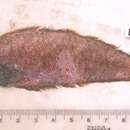Morphology
provided by Fishbase
Dorsal soft rays (total): 99 - 101; Analsoft rays: 78 - 79
- Recorder
- Christine Marie V. Casal
Trophic Strategy
provided by Fishbase
Found along coasts (Refs. 94612, 122781, 122834), continental shelf (Ref. 122779). Feeds on benthic invertebrates. Dwells in benthic sandy substrates (Ref. 127989).
- Recorder
- Rubyann Robelle Polido
Biology
provided by Fishbase
Not recorded from a depth of more than 135 m (Ref. 5297).
Comprehensive Description
provided by Smithsonian Contributions to Zoology
Cynoglossus sinusarabici (Chabanaud)
Dollfusichthys sinusarabici Chabanaud, 1931:304 [type-locality: Suez Canal]; 1934a: 158.—Gruvel and Chabanaud, 1937:6, figs. 5–8.—Ben-Tuvia, 1953:13; 1963:115; 1966:267.
Cynoglossus sinusarabici.—Chabanaud, 1939:30; 1954:465; 1955b: 166.
Cynoglossus branchycephalus [not Bleeker].—Chabanaud, 1951b:78 [with one lateral line].
DESCRIPTION.—Based on 2 specimens, 83.0 and 99.0 mm SL, the lectotype and paralectotype of C. sinusarabici.
Depth of body 23.23–25.30 (M = 24.26), length of head 19.70–20.48 (M = 20.09) percent of standard length. Diameter of eye 15.38–17.65 (M = 16.52) percent of head, interorbital space absent. Two nostrils on ocular side, anterior nostril tubular, in front of lower eye, posterior nostril simple, in front of eyes. Snout rounded, 26.47–30.77 (M = 28.62) percent of length of head, rostral hook short, ends in front of anterior nostril. Maxillary extending below posterior half of fixed eye; angle of mouth extending to below vertical from middle of fixed eye, much nearer to tip of snout than to branchial opening, tip of snout to angle of mouth 43.59–47.06 (M = 45.32), angle of mouth to branchial opening 58.82–61.54 (M = 60.18), percent of length of head.
Scales: Ctenoid on both sides.
Lateral-Line System: Only midlateral line present on ocular side with 54–60 scales, 11 scales from base of dorsal to midlateral line at middle of body. No lateral line on blind side.
Fins: Dorsal with 99–101 rays, anal with 78–79 rays, caudal 8 in 2 specimens (radiograph).
Vertebrae: 48–50 comprising 9 abdominal and 39–41 caudal elements in 2 specimens (radiograph).
Coloration: Upper side uniform brown, lower whitish in preserved specimens.
Size: Largest specimen examined, 107 mm (99 mm SL) is the lectotype of C. sinusarabici.
DISTRIBUTION.—Red Sea, Suez Canal, and eastern Mediterranean (Israel); recorded from a depth of not more than 75 fms.
DIAGNOSIS AND
- bibliographic citation
- Menon, A. G. K. 1977. "A systematic monograph of the tongue soles of the genus Cynoglossus Hamilton-Buchanan (Pisces, Cynoglossidae)." Smithsonian Contributions to Zoology. 1-129. https://doi.org/10.5479/si.00810282.238
Cynoglossus sinusarabici: Brief Summary
provided by wikipedia EN
Cynoglossus sinusarabici, the Red Sea tonguesole, is a species of tonguefish which occurs in the Red Sea and is now common in the eastern Mediterranean Sea following its migration through the Suez Canal. It was first recorded in the Mediterranean Sea off Israel in 1953 and successively observed in Turkey and Egypt. It has an elongated body with a rounded snout which has a rostral hook large, narrowly separated eyes. It has 99-101 dorsal fin rays, 78-79 rays in its anal fin and 8 rays in the caudal fin. The lateral line has 54-60 scales with 11 scales between the lateral line and the base of the dorsal fin. The lateral line is only present on the eyed side. It is uniform brown on the eyed side and whitish on the blind side. It grows to about 15 cm standard length.
- license
- cc-by-sa-3.0
- copyright
- Wikipedia authors and editors

